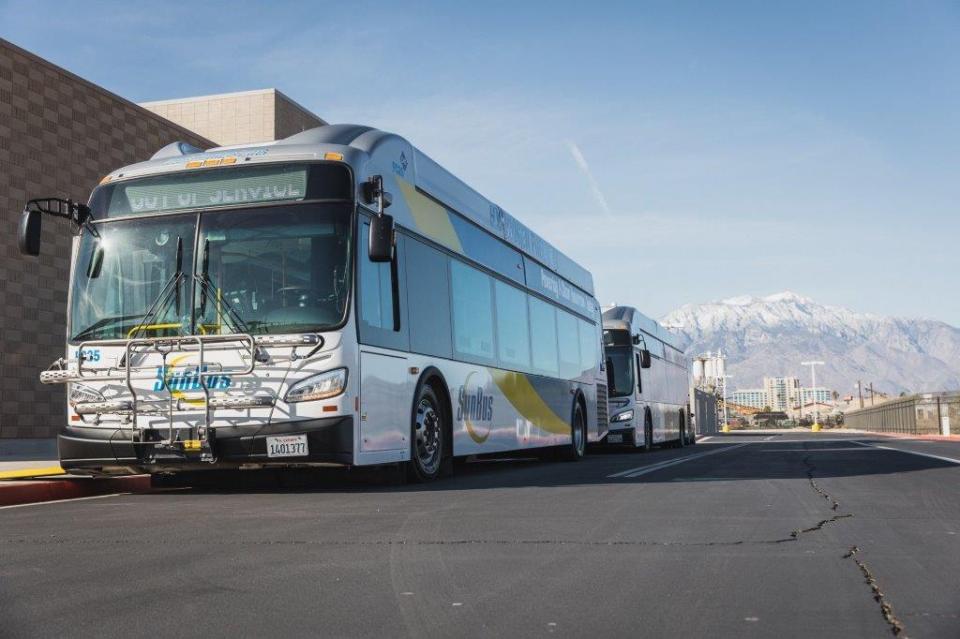STARS Align: PNNL-developed Technology Deployed at Hydrogen Fueling Station
Licensed technology paves the way to hydrogen production for fuel cell electric buses in California

A new hydrogen generator design, about 11 inches in diameter, combined with a microchannel heat exchanger, enables on-site production of hydrogen at fueling stations.
(Image by Scott Butner | Scott Butner Photography, LLC)
Technology developed at the Department of Energy’s Pacific Northwest National Laboratory (PNNL) is at the heart of a first-of-its-kind advanced hydrogen generation station unveiled in Thousand Palms, Calif., in January.
As part of a research demonstration project, the PNNL-developed hydrogen generator will produce hydrogen from renewable natural gas that will help fuel SunLine Transit Agency’s fleet of 17 fuel cell electric buses and support future expansion. The project is a collaboration among Southern California Gas Co. (SoCalGas), SunLine Transit Agency and STARS Technology Corporation, a Richland, Wash., startup company founded in 2017 that has licensed the technology.
“It is exciting to see this technology move so quickly from PNNL to a real-world deployment,” said Christina Lomasney, PNNL’s Director of Commercialization. “This is an example of PNNL’s commitment to helping our nation achieve economic competitiveness and energy security through the commercialization of laboratory-developed technologies.”

The hydrogen generator relies on patented microchannel heat-exchange technology that efficiently transfers heat to enable the chemical reactions needed to produce hydrogen from methane, the main ingredient of natural gas. The PNNL invention is built on a scientific principle related to the efficiency of heat and mass transport through thin channels that was first identified by Albert Einstein in 1905.
The recently deployed commercial prototypes rely on a process in which methane and steam travel through compact spiral microchannels only a few millimeters thick. The microchannels quickly and evenly expose the gas mixture to heat, driving the chemical reactions that free the hydrogen from natural gas and water.
The combination of efficient heating approaches used with the new hydrogen generator, including concentrated solar thermal and inductive solar-electric heating, makes it possible to generate hydrogen from natural gas and water while emitting 30 percent less carbon dioxide than other common methane-to-hydrogen processes. The system at SunLine, for example, includes three microchannel steam reforming reactors that incorporate inductive heating. Just over a year ago, a world-record in electrical-to-chemical efficiency was achieved at PNNL using this technology.
In addition, the microchannel technology enables the generator’s small size and high efficiency, which makes it ideal for on-site production of hydrogen and could help advance the vision for a hydrogen highway, where filling stations for hydrogen-powered cars could become part of the transportation infrastructure.
“This is a big moment,” said Bob Wegeng, president and chief technology officer of STARS TC and former PNNL staff member who was one of the microchannel technology’s original inventors. “It represents years of collaboration with SoCalGas and the first commercial-scale unit that uses the microchannel reactors and heat exchangers we have been developing since our initial demonstrations at PNNL in the late 1990s.”
Development of the microchannel technology hydrogen generator has been supported by the RAPID Institute and offices in the DOE Office of Energy Efficiency and Renewable Energy, including the Hydrogen and Fuel Cell Technologies, Solar Energy Technologies and Advanced Manufacturing and Industrial Decarbonization Offices. It was recognized with an R&D 100 Award in 2014 and a Federal Laboratory Consortium Award for excellence in technology transfer in 2018.
After being invented at PNNL, the hydrogen generator technology was further developed by STARS Technology Corporation, engineered by Barr Engineering Co., fabricated and tested by HiLine Engineering & Fabrication, Inc., and installed by Hal Hays Construction, Inc. and Burns & McDonnell.
PNNL continues to support research, development and deployment related to hydrogen, particularly in the areas of hydrogen storage and materials, hydrogen production and liquefaction, safety and fuel cells.
Published: March 17, 2023